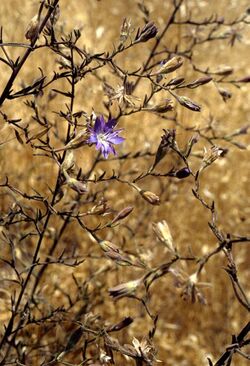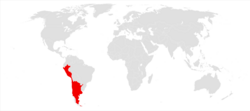Biology:Malesherbia
| Malesherbia | |
|---|---|

| |
| Malesherbia linearifolia | |
| Scientific classification | |
| Kingdom: | Plantae |
| Clade: | Tracheophytes |
| Clade: | Angiosperms |
| Clade: | Eudicots |
| Clade: | Rosids |
| Order: | Malpighiales |
| Family: | Passifloraceae |
| Subfamily: | Malesherbioideae Burnett |
| Genus: | Malesherbia Ruiz & Pav. |
| Type species | |
| Malesherbia tubulosa Cav.
| |
| Species | |
|
25 species, see text | |

| |
| Range of Malesherbia as of 2023 | |
| Synonyms | |
| |
Malesherbia is a genus of flowering plants consisting of 25 species in the Passifloraceae. This is a xerophytic group endemic to the Peruvian and Chile an deserts and adjacent Argentina . The genus is currently recognized by the APG III system of classification in the family Passifloraceae, and is the sole member of the subfamily Malesherbioideae.[1][2]
Description
Malesherbia is a genus of herbaceous plants to shrub. They have perfect flowers that come in various shades of red, pink, pale yellow, white, and purple.[3]
Taxonomy
In 1794, Hipólito Ruiz López and José Antonio Pavón Jiménez would describe Malesherbia.[4] Malesherbia was distinguished from other genera due to its small five parted limbus, ovulate open jaciniis, five petals that are inserted at the interstices of the throat of the calyx, five oblong and bilocular anthers, three pistils, and several other traits.[4] The genus is named after Chrétien Guillaume de Lamoignon de Malesherbes.[4] In their original description, the type species was not named.
In 1798, Antonio José Cavanilles would describe the genera under Gynopleura. Cavanilles admitted that Malesherbia was described exactly as Gynopleura, however, the seeds of Malesherbia were not described in the original text, and thus Cavanilles felt justified in publishing the genera under Gynopleura.[5] Cacanilles would however establish M. tubulosa as the genera's type species.
Distribution
Members of Malesherbia are native to South America, specifically the arid and Andean regions of Perú, Chile and Argentina.[6][7]
Species
Species accepted by the Plants of the World Online as of 2022:[8]
- Malesherbia angustisecta Harms
- Malesherbia ardens J.F.Macbr.
- Malesherbia arequipensis Ricardi
- Malesherbia auristipulata Ricardi
- Malesherbia bracteata Phil.
- Malesherbia corallina Muñoz-Schick & R.Pinto
- Malesherbia densiflora Phil.
- Malesherbia deserticola Phil.
- Malesherbia fasciculata D.Don
- Malesherbia fatimae Weigend & H.Beltrán
- Malesherbia haemantha Harms
- Malesherbia humilis Poepp.
- Malesherbia lactea Phil.
- Malesherbia laraosensis H.Beltrán & Weigend
- Malesherbia linearifolia (Cav.) Poir.
- Malesherbia lirana Gay
- Malesherbia paniculata D.Don
- Malesherbia scarlatiflora Gilg
- Malesherbia solanoides Meyen
- Malesherbia splendens Ricardi
- Malesherbia tenuifolia D.Don
- Malesherbia tocopillana Ricardi
- Malesherbia tubulosa (Cav.) J.St.-Hil.
- Malesherbia turbinea J.F.Macbr.
- Malesherbia weberbaueri Gilg
Phylogeny[9]
| ||||||||||||||||||||||||||||||||||||||||||||||||||||||||||||||||||||||||||||||||||||||||||||||||||||||||||||||||||||||||||||||||||||||||
Please note, this phylogeny does not include Malesherbia laraosensis. As of 2022, a phylogenetic analysis including M. laraosensis has not been published.
References
- ↑ Stephens, P.F. (2001 onwards). Angiosperm Phylogeny Website. Version 9, June 2008. http://www.mobot.org/MOBOT/Research/APweb/
- ↑ "Angiosperm Phylogeny Website". http://www.mobot.org/MOBOT/Research/APweb/.
- ↑ Bull-Hereñu, Kester; Ronse De Craene, Louis P. (2020). "Ontogenetic Base for the Shape Variation of Flowers in Malesherbia Ruiz & Pav. (Passifloraceae)". Frontiers in Ecology and Evolution 8. doi:10.3389/fevo.2020.00202. ISSN 2296-701X.
- ↑ 4.0 4.1 4.2 Ruiz, López; Hipólito, Pavón; Jiménez-Villanueva, José Antonio (1794) (in la). Florae peruvianae, et chilensis prodromus, sive novorum generum plantarum peruvianarum, et chilensium descriptiones, et icones.. Madrid: Madrid: in Sancha's printing press. pp. 45. https://bibdigital.rjb.csic.es/idurl/1/9556.
- ↑ Ruiz, Hipólito (1798) (in la). Florae peruvianae, et chilensis, sive, Descriptiones, et icones plantarum peruvianarum, et chilensium, secundum systema Linnaeanum digestae, cum characteribus plurium generum evulgatorum reformatis.. 3. [Madrid] : Typis Gabrielis de Sancha.. pp. 2, 30–31. https://archive.org/details/floraeperuvianae03ruiz/page/n7/mode/1up?q=Malesherbia.
- ↑ Gengler-Nowak, Karla (2002-01-01). [0171:ROTBHO2.0.CO;2 "Reconstruction of the biogeographical history of Malesherbiaceae"] (in en). The Botanical Review 68 (1): 171–188. doi:10.1663/0006-8101(2002)068[0171:ROTBHO2.0.CO;2]. ISSN 1874-9372. https://doi.org/10.1663/0006-8101(2002)068[0171:ROTBHO]2.0.CO;2.
- ↑ Guerrero, Pablo C.; Rosas, Marcelo; Arroyo, Mary T. K.; Wiens, John J. (2013-07-09). "Evolutionary lag times and recent origin of the biota of an ancient desert (Atacama–Sechura)" (in en). Proceedings of the National Academy of Sciences 110 (28): 11469–11474. doi:10.1073/pnas.1308721110. ISSN 0027-8424. PMID 23798420. Bibcode: 2013PNAS..11011469G.
- ↑ "Malesherbia Ruiz & Pav. | Plants of the World Online | Kew Science" (in en). http://powo.science.kew.org/taxon/urn:lsid:ipni.org:names:327130-2.
- ↑ Gengler-Nowak, Karla M. (April 1, 2003). "Molecular Phylogeny and Taxonomy of Malesherbiaceae". Systematic Botany 28 (2): 333–44. doi:10.1043/0363-6445-28.2.333. https://bioone.org/journals/systematic-botany/volume-28/issue-2/0363-6445-28.2.333/Molecular-Phylogeny-and-Taxonomy-of-Malesherbiaceae/10.1043/0363-6445-28.2.333.short.
Wikidata ☰ Q132702 entry
 |

